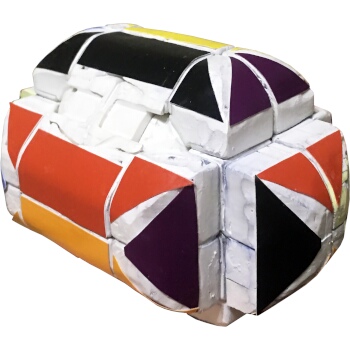
Above:View 1
Click a thumbnail to see its larger version and description.
A hexahedral relative of the 18x19x37 tharsis.
Ilya Toporgilka had thought about this design since 2020 and finished it at the end of 2022.
Initially he wanted to see a 5x6x7 brick cuboid, after some tries it seemed that the only way to achieve that was to make edge and corner cubies wider than the centers, like on a cubic 7x7x7, with straight cuts, flat sides and proportional pieces 8 corners of the cuboid can't be attached.
In 2020 Ilya Toporgilka remembered the 5x6x7 seen earlier in the museum figured out a way to build it with cubies looking proportional. The plans were to build a 5x6x7 with unproportional cubies still but which, on the other side, looks like they are all proportional and the same. With this way the corners could be attached. The following thoughts were how to hide the unproportionality and create the illusion of every cubie being comprised of squares.
After making a pentaemperor hexadecagonal prism in 2022, Ilya Toporgilka tried to adapt this technique to see if something like a "big brick cuboid" could be made with this way. Surprising was that the brick cuboids could not be made even the way the prism had been made because they did not reduce like a pentaemperor hexadecagonal prism and a 44x55x55 crazypill. By multiplying a set of 3 numbers (one of which is 1 more than the other one), 2 numbers with a difference of 1 can never appear. Thus conveying a brick cuboid in something like a disc or ellipsoidal form did not work out.
With his creation of the void crazy 22-layer tetradecaemperor face turning octagonal prism Ilya Toporgilka noticed that a descending multilayer cross cube/cuboid in an attempt to smooth out the jagged form reduces to 2 if a dimension is even or 3 if the dimension is odd. Then he thought about the brick cuboid(also with the third number being different than the second by 2,3,4,5,etc because with cuboids like 3x3x6 or 3x4x6 there was a difficulty trying to set the indermediate 2 layers because of the thickness of their teeth.
So Ilya Toporgilka tried again the straight cuts, flat sides and proportional pieces but with extruded faces. He tried this approach for the FTO or the gigaminx or puzzles with the same axis systems. Finally he settled for a hexahedral axis system based on a 2x3x3.
Ilya Toporgilka started with a 4x4x4 (64 mm) bandaged it into a 2x3x3 and truncated it into the shape seen here. The second and third numbers had to be laying on the 3 side and be odd. The first one had to be laying on the 2 side and thus be even. If the 4x4x4 has 16mm cubies, a tharsis is a 18x19x37. The last number cannot be closer to the second one. A 4x4x4 has to have 16mm cubie each, the one with 15mm cubies is not suitable.
Tharsis is the name of another multi-layered cross puzzle. The designer reused that name for his creation.
Links

Contributors
No one has contributed to this page yet!
Collections
No one has added this puzzle to a collection yet!
Found a mistake or something missing?
Edit it yourself or
contact the moderator.





